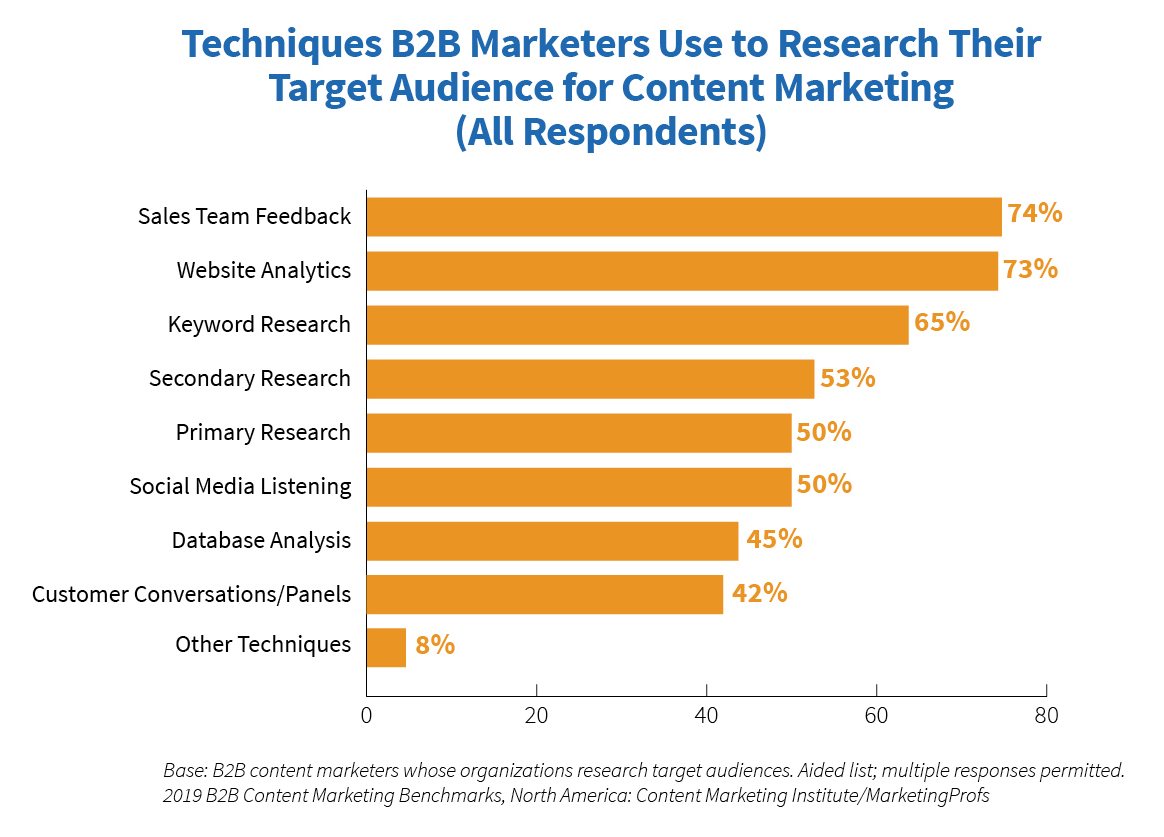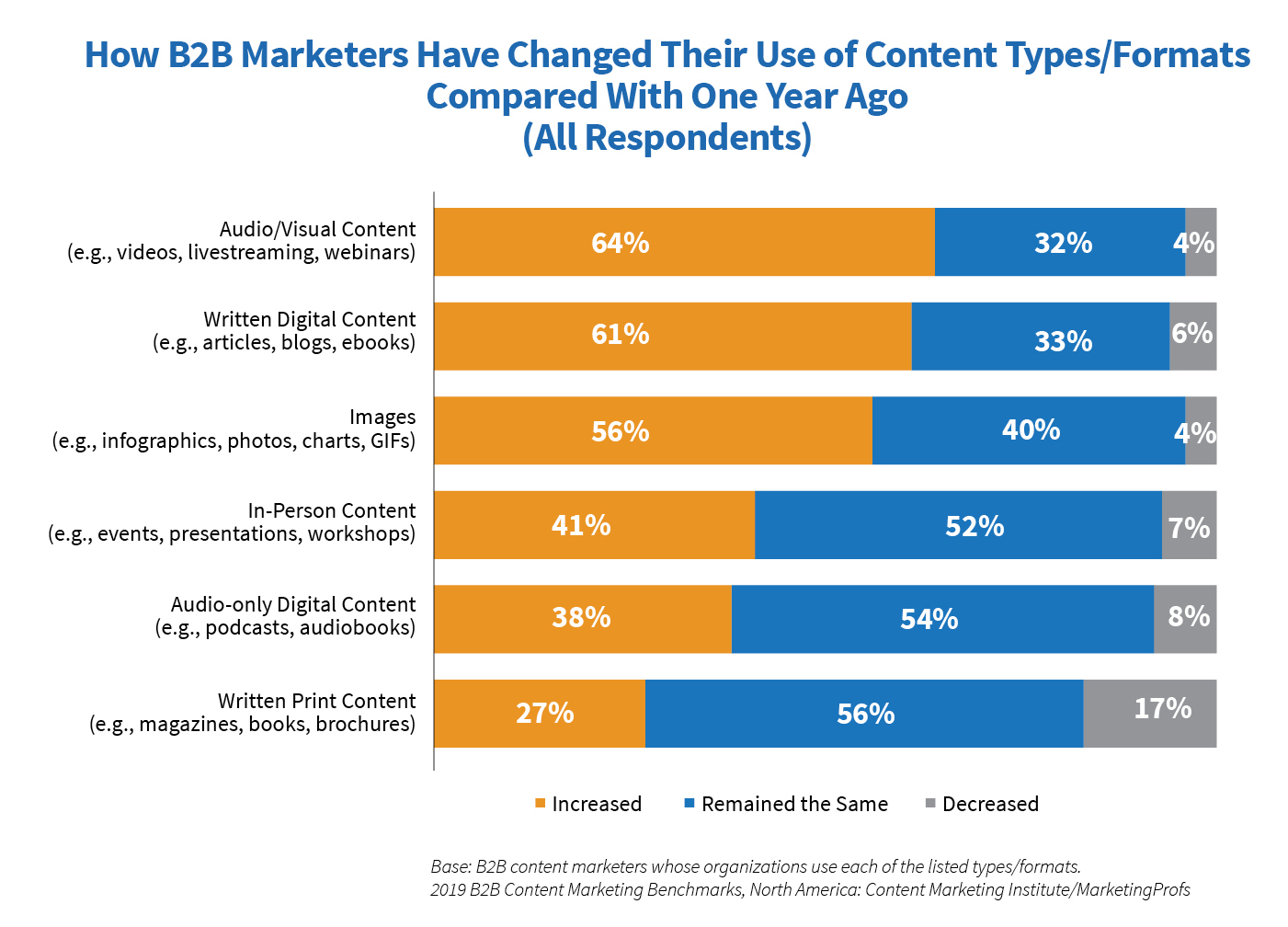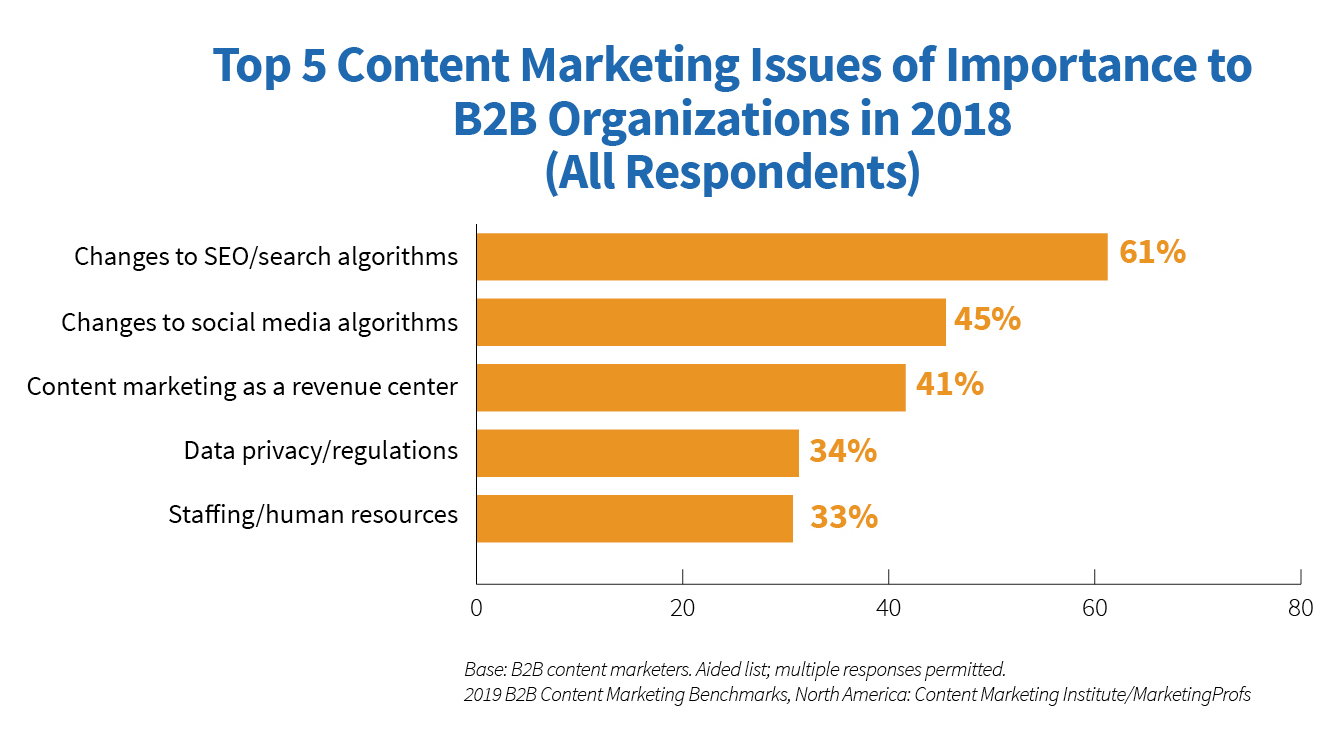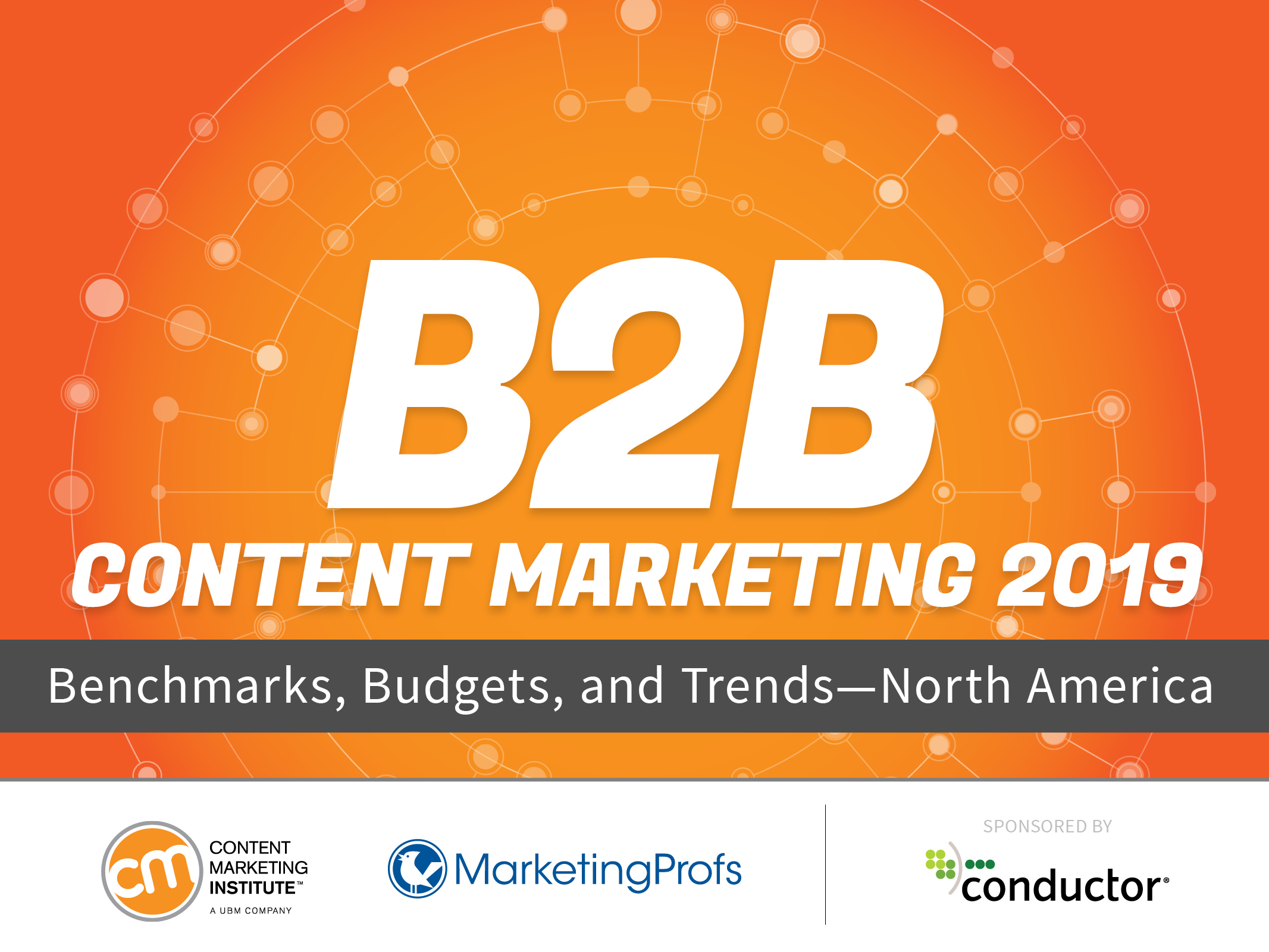You’ve come a long way, content marketers. Today, nearly all top-performing B2B content marketers – 90% – put their audience’s informational needs ahead of their company’s sales/promotional message.
Ten years ago, when CMI founder Joe Pulizzi cowrote Get Content Get Customers, content marketing was a novel concept for many traditional marketers. That it’s a common practice now shows how much marketers have adjusted their thinking.
90% of top-performing #B2B #content marketers put audience’s informational needs first. @cmicontent. #research Click To TweetHow content marketers reach those audiences, where they’re investing to do it, and what they’re most concerned about are a few of the new findings presented in CMI and MarketingProfs’ ninth annual B2B Content Marketing 2019: Benchmarks, Budgets, and Trends—North America report, sponsored by Conductor. We present the research every fall to help content marketers plan for the coming year.
This year, we made a significant change in the methodology. We limited the survey to respondents whose organizations have used content marketing for at least one year. In addition, we qualified the respondents by asking them to confirm they are a content marketer, someone who is involved with content marketing, or someone to whom content marketing staff reports. This gave us a more experienced pool of practicing content marketers and, we feel, more robust insights.
Here are some highlights from the 2019 report.
Content marketers are successfully building trust
When you put your audience’s needs first – and create your content based on THOSE needs – what are you really trying to do? Of course, you want your content to get found, consumed, discussed, and/or shared, to generate action by your audience. You want the right people to find value in your content and subscribe to it.
But what’s happening on a deeper level when you help someone by providing valuable information? Our research indicates you’re creating a bond: 96% of the most successful content marketers agree their audience views their organization as a credible and trusted resource.
96% most successful #B2B #content marketers say audiences view their company as trusted resource. @cmicontent Click To TweetSuccess in creating this bond isn’t limited to the most successful content marketers: 68% of all B2B marketers say they’ve used content marketing successfully to build credibility with their audience.
How you can use this insight
CMI Chief Strategy Advisor Robert Rose recently described the importance of earning not only our audience’s attention, but also its trust: “Every digital experience we create should not only reflect our focus on winning a moment of truth – where the customer is paying attention – but in deepening the trust gained (or regained) in every step that precedes or follows it.”
Earning that trust requires your content to have four essential traits, Robert writes. It must be:
- Risk appropriate (avoid asking for something before proving the value)
- Consistent (deliver reliable content regularly over time)
- Personal (based on reliable information the visitor has willingly given)
- Cumulative (building on what came before)
In short, if you want your brand to be well-regarded by your audience, give it something valuable. Be consistent. Be easy to find. Give your audience members content they want and need – when and where they’re looking for it. And make it about them, not you.
If you want to build trust with your audience, give them something valuable, says @LisaBeets. Click To TweetLess than half of content marketers talk to customers
About three out of four B2B content marketers seek feedback from sales and use website analytics to research their audience, while 65% use keyword research.
That’s a pleasant surprise considering how often we hear that marketing and sales teams need to do a better job of communicating.
But relatively few B2B content marketers research their audience by talking to their customers. Only 42% say they have conversations with customers as part of their audience research.

This year’s research also found that 73% of those surveyed use or plan to use personas for content marketing purposes by the end of 2018.
73% of #B2B content marketers plan to use personas for #contentmarketing purposes by end of 2018. @cmicontent Click To TweetHow you can use this insight
Effective personas are based on research about real people. “Nothing beats the ability to get information directly from current customers,” Jodi Harris wrote in the Quick and Dirty Guide for Creating Actionable Content Marketing Personas. That’s because customers can tell you directly about their needs and preferences. You don’t have to infer them from analytics or glean them from third-party conversations.
Nothing beats the ability to get information directly from current customers, says @joderama. Click To TweetIf your team isn’t talking with customers, look for ways to make this happen. Some content marketers accompany sales reps on their calls. Some arrange phone calls with prospects and customers directly. Take advantage of in-person events your audience members attend to talk to them.
Email campaigns and educational content reign
Fifty-eight percent of respondents say they’ve used content marketing successfully to nurture subscribers, audience, or leads in the last 12 months. The top two methods are email (87%) and educational content (77%).
Email & educational content are top 2 ways #B2B content marketers nurture their audience via @cmicontent. Click To Tweet
Only 23% of respondents indicate their organization is working to build community among their audience or inviting audiences to participate in discussions.
How you can use this insight
Email campaigns and educational content done well are reliable ways to nurture relationships. Pay attention to your audience’s changing preferences, though, to spot new opportunities. Given the fierce competition in inboxes these days, you might consider experimenting with other channels, such as the blend of email and SMS messaging, as Ardath Albee described in a talk earlier this year.
Spending on content creation increased
Content creation is where respondents were most likely to report an increase in spending over the last 12 months (56%). Increased spending on content marketing staff came in a distant second (37%), followed closely by paid content distribution (36%).

Video rises, text-based content keeps pace
We organized content types into six “buckets” to examine broader use trends. As shown in the chart, more than 50% of respondents increased their use compared with a year ago in three content buckets:
- Audio/visual (e.g., videos and webinars)
- Text-based digital (e.g., articles and e-books)
- Images (e.g., infographics, charts, and photos)

How you can use this insight
Which content types will generate the best results for your organization depends on many factors – the nature of your business, the demographics and preferences of your audience, your goals, etc. Don’t assume, for example, that content type buckets with a less than 50% increase won’t be valuable for your organization. Experimentation plays a big role in any content marketing initiative. For example, a podcast or a print magazine may be a great opportunity for your organization depending on your audience and resources.
SEO/search algorithms are top of mind
When asked about content marketing issues their organizations are concerned about, the top three answers were changes to SEO/search algorithms (61%), changes to social media algorithms (45%), and content marketing as a revenue center (41%).
#SEO/search algorithms are a top concern for 61% of B2B marketers via @CMIContent 2019 #research. Click To TweetRelatively few cite emerging technologies such as artificial intelligence (14%) and preparing content for voice search (13%) as a concern, though those topics capture a lot of buzz in marketing conversations.

How you can use this insight
Keeping up with changing social and search algorithms can feel like a never-ending battle. But resources that can help do exist. Earlier this year, Content Marketing World speakers shared their advice on coping with social algorithm changes. For a list of SEO resources (including experts, articles, blogs, and tools), take a look at the recap of this #CMWorld Twitter chat featuring SEO expert Stephan Spencer.
The story doesn’t end here
This year’s research uncovered many other new insights such as:
- The top benefits marketers say they derive from their documented content marketing strategy
- How marketers rate their organization’s proficiency level with using content marketing technologies – and the benefits they derive from using those technologies
- The types of paid methods they use to distribute content – and why
- Goals achieved over the last 12 months
View the report today to see all the findings and watch this blog for more analysis of the results.
Thanks to all our survey respondents, distribution partners, sponsor Conductor, and everyone who helps disseminate these findings across the content marketing industry. We could not produce this research without you. Special thanks to Nancy Reese, CMI research consultant, for her contributions and dedication to this project.
Cover image and report design by Joseph Kalinowski/Content Marketing Institute

